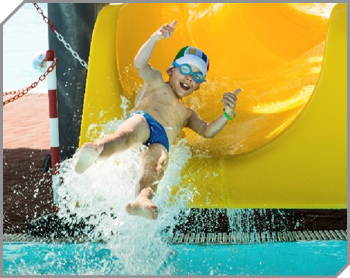Healthier and safer in the water
The 2018 Model Aquatic Health Code (3rd Edition) helps make swimming and other water activities healthier and safer.

With temperatures soaring this summer, many Americans are heading to public pools and water playgrounds at waterparks, community rec centers, hotels/motels, and apartment/condo complexes to cool down. A partnership between CDC and the Council for the Model Aquatic Health Code (CMAHC) is helping make public aquatic venues healthier and safer for swimmers and aquatics staff.
Promoting Health and Safety
The CMAHC was formed in 2013 to develop, promote, and update CDC’s Model Aquatic Health Code (MAHC). You might wonder what the MAHC has to do with pools and water, and how it keeps you and your family safe. It’s a voluntary set of guidelines based on science and best practices that help government agencies and the aquatics industry make swimming and other water activities healthier and safer. The guidelines include recommendations on how to best design, construct, operate, and maintain public aquatic venues.
The recommendations in the MAHC can help reduce the number of outbreaks of waterborne illnesses, drowning incidents, and injuries from pool chemicals and other causes. In the long run, this means the number of pools that are open, healthy, and safe goes up.
The 2016 Model Aquatic Health Code, 3rd Edition, released in July 2018, includes new and revised recommendations in the areas of disinfection and water quality, lifeguarding and bather supervision, risk management and safety, and ventilation and air quality.
Keeping Americans Safe through Strong Partnerships

Government agencies and the aquatics industry now have the opportunity to voluntarily adopt the MAHC to help keep swimmers and aquatics staff safer and healthier, and it wouldn’t be possible without the CMAHC. The CMAHC brings together the combined expertise of public health professionals, the aquatics industry, and researchers across the U.S. to tackle water health and safety issues. It collects, assesses, and relays input on proposed MAHC revisions to CDC for consideration, ensuring that the MAHC is regularly improved and updated with the latest science, industry advances, and public health data. The CMAHC also develops materials to educate professionals and the public about the MAHC guidelines and provides technical assistance to health departments, boards of health, legislatures, and other partners on MAHC uses and benefits.
The CMAHC was instrumental in developing the 3rd edition of the MAHC, which strengthened the original guidelines. Like the second edition, the new edition ensures that a variety of perspectives, including those of experts working within the aquatic sector and at local and state public health agencies, were considered. The CMAHC’s strong partnership with CDC helps protect the public’s health while supporting healthy, safe, and cool summertime activities for everyone.
- Explore the MAHC website to check out the 2018 edition and supporting materials.
- Join the Council for the Model Aquatic Health Code, which collects and votes on proposed MAHC changes to recommend to CDC for final decision.
- Join the Network for the Model Aquatic Health Code, a community of MAHC users, subject matter experts, and those hoping to learn about the code (includes regular webinars).
- Page last reviewed: July 23, 2018
- Page last updated: July 23, 2018
- Content source:
Centers for Disease Control and Prevention
National Center for Emerging and Zoonotic Infectious Diseases (NCEZID)


 ShareCompartir
ShareCompartir